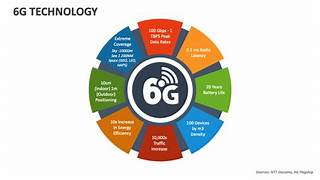How Will the Introduction of 6G Change Our Communication Patterns?
The sixth generation of wireless technology, or 6G, is more than just the next step in mobile communications. It represents a transformative leap that will redefine how humans, machines, and networks interact. While 5G has already brought faster speeds, lower latency, and the ability to connect more devices simultaneously, 6G promises to enhance these features exponentially. It is expected to deliver unprecedented data rates, seamless connectivity, and the fusion of the physical, digital, and biological worlds.
This article explores how 6G will influence our communication patterns, reshaping personal interactions, professional collaboration, and the global digital ecosystem.
The Foundations of 6G Technology
1. Unprecedented Speed and Bandwidth
6G networks are expected to provide data transfer rates of up to 1 terabit per second (Tbps), far surpassing the gigabit speeds of 5G. Such speeds will enable near-instantaneous communication and unlock new possibilities for data-heavy applications like holographic conferencing and real-time virtual reality.
2. Ultra-Low Latency
Latency in 6G networks will likely be reduced to microseconds, ensuring almost real-time responsiveness. This improvement will be crucial for applications requiring high precision, such as autonomous vehicles, remote surgery, and industrial automation.
3. Integration with AI and Edge Computing
6G networks will seamlessly integrate with artificial intelligence (AI) and edge computing, enabling smarter, faster decision-making. AI-driven networks will optimize communication pathways, ensuring efficient data delivery.
4. Terahertz Spectrum
6G will utilize terahertz frequencies (THz), which offer greater capacity and speed but require advancements in signal propagation technologies to overcome challenges like shorter range and susceptibility to interference.
Transforming Communication Patterns
1. Personal Communication
The introduction of 6G will profoundly affect how individuals interact with each other.
- Holographic Communication: Imagine talking to a friend or colleague, not through a video call, but via a fully immersive holographic projection. 6G’s high data rates will make such experiences seamless and commonplace, making distant interactions feel almost physical.
- Real-Time Language Translation: 6G will enable instant, high-quality translation during conversations, breaking down language barriers and fostering global connections.
- Ubiquitous Connectivity: With 6G, connectivity will extend to even the most remote areas, ensuring that everyone has access to fast and reliable communication, bridging the digital divide.
2. Professional Collaboration
6G will redefine workplace communication, enabling new modes of collaboration and innovation.
- Immersive Workspaces: Virtual reality (VR) and augmented reality (AR) will replace traditional video conferencing. Employees can meet in virtual spaces, manipulate 3D objects together, or walk through virtual prototypes, all in real time.
- Smart Assistants: AI-powered virtual assistants will become more intuitive, handling complex tasks, scheduling, and even predicting workplace needs based on communication patterns.
- Global Remote Work: The seamless connectivity of 6G will make remote work indistinguishable from in-person collaboration, supporting global teams with ultra-high-definition interactions and low-latency tools.
3. Machine-to-Machine Communication
6G will enable massive-scale machine-to-machine (M2M) communication, which will significantly alter communication patterns in industries.
- Autonomous Systems: Autonomous vehicles, drones, and robots will communicate and coordinate in real-time, enabling safer and more efficient operations.
- Industrial IoT: Factories will become hyper-connected, with machines exchanging vast amounts of data instantly to optimize production lines and predict maintenance needs.
- Smart Cities: 6G will support interconnected urban ecosystems where traffic systems, energy grids, and public services communicate seamlessly to improve efficiency and quality of life.
4. Enhanced Human-Machine Interaction
6G will blur the lines between human and machine communication.
- Brain-Computer Interfaces: Advanced neural interfaces will allow users to control devices with their thoughts, opening up new avenues for accessibility and productivity.
- Wearable and Embedded Technology: Smart wearables and implanted devices will provide real-time health monitoring, enabling personalized medical interventions and enhancing human capabilities.
Social Implications
1. Redefining Relationships
The immersive nature of 6G-enabled communication could redefine how people form and maintain relationships. Holographic and VR interactions will make long-distance relationships feel more intimate, while real-time language translation will foster cross-cultural connections.
2. Education and Learning
6G will revolutionize education by enabling immersive, interactive, and personalized learning experiences. Virtual classrooms will become indistinguishable from physical ones, and students will be able to explore simulations of historical events, scientific phenomena, or even distant planets in real time.
3. Entertainment and Media
6G will transform how content is created, shared, and consumed.
- Hyper-Realistic Media: Streaming ultra-high-definition 3D content will become standard, providing viewers with immersive experiences.
- Collaborative Content Creation: Artists and creators worldwide will collaborate in real-time virtual spaces, pushing the boundaries of creativity.
- Interactive Experiences: Viewers will become participants in stories, controlling narratives or exploring immersive worlds.
Challenges and Ethical Considerations
1. Privacy and Security
The extensive connectivity and data exchange facilitated by 6G raise concerns about privacy and cybersecurity. With more devices and data streams, protecting personal and organizational information will become increasingly challenging.
2. Digital Divide
While 6G promises ubiquitous connectivity, the cost of deploying and accessing such advanced technology may widen the digital divide in the short term, particularly in developing regions.
3. Environmental Impact
The infrastructure required for 6G, including terahertz antennas and advanced data centers, could significantly increase energy consumption, raising questions about sustainability.
4. Ethical Use
As AI and machine-learning algorithms play a larger role in 6G networks, ensuring ethical and unbiased decision-making will be critical. Misuse of the technology for surveillance or manipulation must be addressed through robust regulations.
The Future of Communication with 6G
6G is not just an upgrade to 5G—it represents a paradigm shift in how we communicate and interact with the world. Its integration with AI, IoT, and emerging technologies will enable unprecedented levels of connectivity and intelligence. However, realizing its full potential requires addressing the challenges of security, equity, and sustainability.
The introduction of 6G will transform communication patterns in ways we are only beginning to imagine. By preparing for this transformation now, society can harness the benefits of 6G while mitigating its risks, ensuring that this technological leap serves as a force for progress and inclusion.


